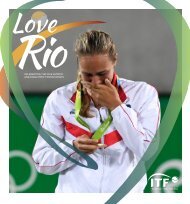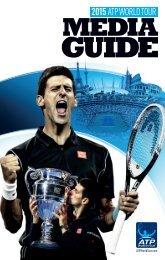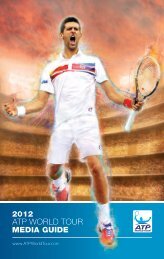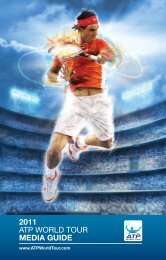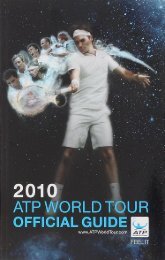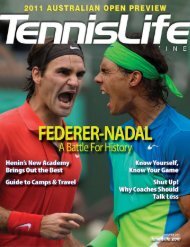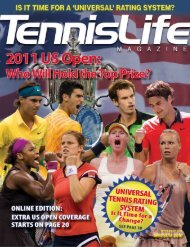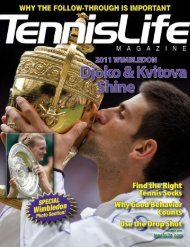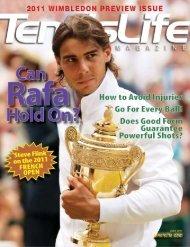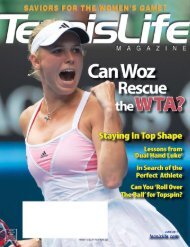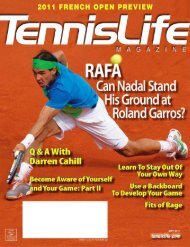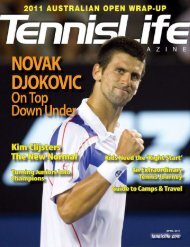A Champion's Mind - Pete Sampras
www.tennismoscow.me Insta:TENNISMOSCOW
www.tennismoscow.me Insta:TENNISMOSCOW
You also want an ePaper? Increase the reach of your titles
YUMPU automatically turns print PDFs into web optimized ePapers that Google loves.
intimacy (for 2009, Centre Court will have a retractable roof that covers everything).<br />
In comparison, the Rod Laver Arena at the Australian Open is antiseptic, featureless, and, seemingly,<br />
vast. When you’re standing at the baseline looking across the net, it seems miles to the wall at the far end<br />
of the court. And that makes the actual court seem smaller than it really is. I always preferred architecture<br />
that made the actual court of play seem larger.<br />
The Philippe Chatrier Court at Roland Garros is also huge, with a lot of space around the lines of the<br />
court. That always added to my feeling that I couldn’t really control what went on in there—it was too<br />
much territory. That uncomfortable feeling is somewhat legitimate, too, because on clay you actually do<br />
play on a much larger court—at least in terms of how much space you use. You often play from much<br />
farther behind the baseline on clay, you chase balls farther than on any other surface, and you’re often<br />
pulled wider from side to side.<br />
That leaves Arthur Ashe Stadium at the USTA Billie Jean King National Tennis Center in New York,<br />
and while it’s the most imposing of the Grand Slam venues, the court and space around it, surprisingly, are<br />
just about right. I guess those towering walls make the court feel smaller. Many players beef about how<br />
hard it is to concentrate in Ashe because of the restless, chatty New York crowd, but that was never a<br />
problem for me. However, I liked the old Louis Armstrong Stadium court (which was the main court<br />
before Ashe was built and is now the secondary feature court) even better, probably because it felt a little<br />
smaller—although nothing like Centre Court.<br />
There was a definite psychology at play in this. The smaller a court appeared to be, and the closer the<br />
far side seemed to be, the faster the court seemed to play. And that always gave me extra confidence,<br />
because I liked fast tennis. I wonder if the illusion affected my opponents as well.<br />
At Wimbledon, the court is completely and inescapably the center of attention—there’s no plane noise<br />
and no JumboTron or complicated digital scoreboard to distract you with stock prices, NFL scores, or<br />
ads. The space around the court at Wimbledon is limited, and the backdrop is dark, with very little<br />
advertising or busy features. The dark background also makes the pale green grass look extra-inviting;<br />
aesthetically, grass courts have it all over a dusty stretch of clay, or bland hard courts.<br />
I enjoyed the relative “softness” of the court; it was terrific to feel that sod gently give way beneath my<br />
feet with every step. I felt catlike out there, like I was on a soft play mat where I could do as I pleased<br />
without worry, fear, or excessive wear and tear. Centre Court always made me feel connected to my craft,<br />
and the sophisticated British crowd enhanced that feeling. It was a pleasure to play before them, and they<br />
inspired me to play my best. Wimbledon is a shrine, and it was always a joy to perform there.<br />
As it turned out, Lindsay upset Steffi, and the crowd didn’t seem to know how to react. The atmosphere<br />
as Andre and I took the court was muted, and a little strange. It was the kind of thing that rarely happens at<br />
Wimbledon, where they know how to give every match its due. But because of the rain, things were a<br />
little off. There was still an abundance of empty seats because many people decided to take a break<br />
between matches. Those in the stands were probably still trying to process what they’d just seen, and<br />
weren’t ready to focus on something else.<br />
Andre and I felt our way into the match gingerly, just like the fans. We held serve to 3–all, but then<br />
Andre got hold of my serve a few times and had me pinned, love–40, in the seventh game. I somehow<br />
survived that scare. Andre served the next game with new balls, and a funny thing happened. He missed a<br />
few easy balls and I hit a few good returns. It might have been that he was distracted by having let me off<br />
the hook in that previous game, but whatever the reason, just like that, I had a break and I held serve to go<br />
up a set. It was a classic grass-court reversal of fortune.<br />
My confidence was ignited, and Andre’s style of play fed the fire. He was my most dangerous career<br />
rival, but he was also one of the few baseliners I played in a Wimbledon final. He gave me a little more



